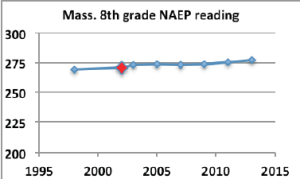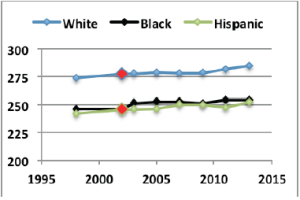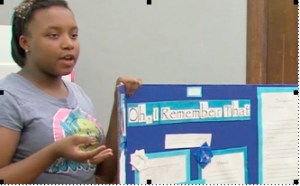1. It hasn’t worked.
High-stakes testing – making major decisions based on standardized tests – has failed.
 The National Assessment of Educational Progress (NAEP) tests students in grades 4, 8, and 12 for reading and math. In these charts, red points show 2002 when NCLB took effect. The MCAS graduation requirement began in 2003.
The National Assessment of Educational Progress (NAEP) tests students in grades 4, 8, and 12 for reading and math. In these charts, red points show 2002 when NCLB took effect. The MCAS graduation requirement began in 2003.
 The charts show high-stakes testing has had no visible impact on the skills measured by standardized tests. Reading scores were rising slowly before NCLB and are still rising slowly.
The charts show high-stakes testing has had no visible impact on the skills measured by standardized tests. Reading scores were rising slowly before NCLB and are still rising slowly.
High-stakes testing was supposed to close achievement gaps among ethnic and racial groups, and between students with disabilities and students without disabilities.
That hasn’t happened.
Math trends, not shown here, tell a similar story. Math scores were rising a bit faster than reading before high-stakes testing and that has continued. Achievement gaps are steady.
See for yourself: More NAEP data for both subjects and all three grades is posted here and here.
2. It hurts students.
 High-stakes testing has narrowed the curriculum and forced schools to waste time prepping students for the specific, limited types of questions and formats on the state test.
High-stakes testing has narrowed the curriculum and forced schools to waste time prepping students for the specific, limited types of questions and formats on the state test.
“Twenty-first century skills” such as problem-solving, teamwork, and creativity have gotten short shrift because there’s no time.
History, art, music, drama, and physical education have been cut.
The biggest cutbacks are in schools with large numbers of low-income children and children who are not yet fluent in English. Those schools feel the most pressure to raise scores.
In a Boston Teachers Union survey, most teachers responding said they lose 16 or more days because of testing. That adds up to a full year spent on testing instead of learning over the course of a student’s career.
The Boston teachers also said they devoted a quarter or more of their teaching time to test prep.
See for yourself: More survey results are posted here.
3. There are better alternatives.
 In New York City, a group of 48 high schools has proven the value of performance-based assessments, operating with a waiver from the state Board of Regents. Their student outcomes are far superior to other schools’.
In New York City, a group of 48 high schools has proven the value of performance-based assessments, operating with a waiver from the state Board of Regents. Their student outcomes are far superior to other schools’.
See more at bit.ly/edweekauthentic and http://performanceassessment.org.
New Hampshire has a waiver from the US Department of Education to develop a similar system to replace their state test. Read more at education.nh.gov/assessment-systems.
In California, the new “Local Control and Accountability” system allows each district to decide its own goals. Read more at bit.ly/lcapfactsheet.
 Holy Cross Prof. Jack Schneider has developed an assessment system for Somerville schools that starts with the simple question: What do we want our children to get out of their schools? It includes standardized tests but also a much wider array of measures.
Holy Cross Prof. Jack Schneider has developed an assessment system for Somerville schools that starts with the simple question: What do we want our children to get out of their schools? It includes standardized tests but also a much wider array of measures.
See what he had to say at the State House hearing on testing legislation. There’s a link to it at bit.ly/testingtestimony.
In 1993, the Massachusetts legislature voted for a “Massachusetts Comprehensive Assessment System,” MCAS. But we never got a comprehensive assessment system. All we got was a Massachusetts Test, which even the Commissioner of Elementary and Secondary Education now says was “never designed to be an indicator of college and career readiness.”
Now is the time for a moratorium on high-stakes testing so we can develop a better system that helps each community educate all of its students.
Support the Less Testing, More Learning bills: H.340, H.418, H.497, S.311, S.257, S.294, and H.3395.
These bills would not scrap standardized testing. They would stop the misuse of test scores to penalize students, teachers, schools and districts. That would make it possible for districts to cut out the preparatory tests and lessons whose sole purpose is to improve scores.
Read more at bit.ly/lesstestbills. Click here for a version of this flyer you can download and print. Click here for a Spanish language version of this fact sheet.

